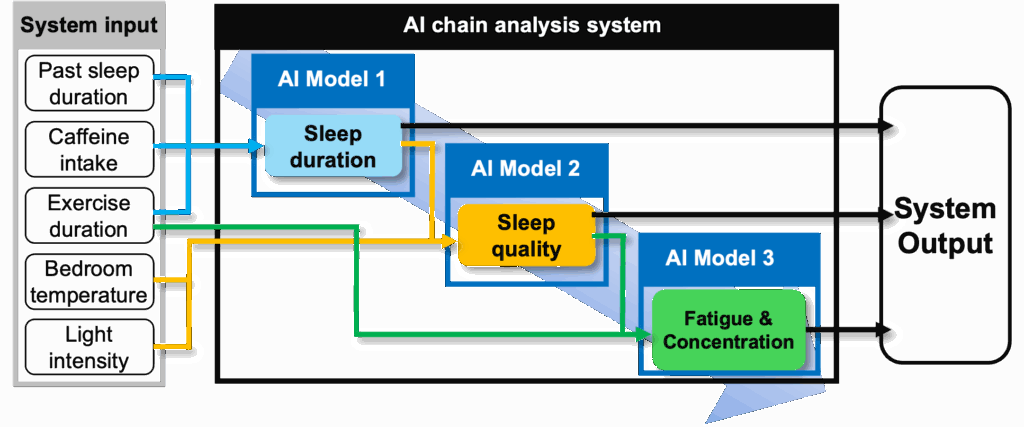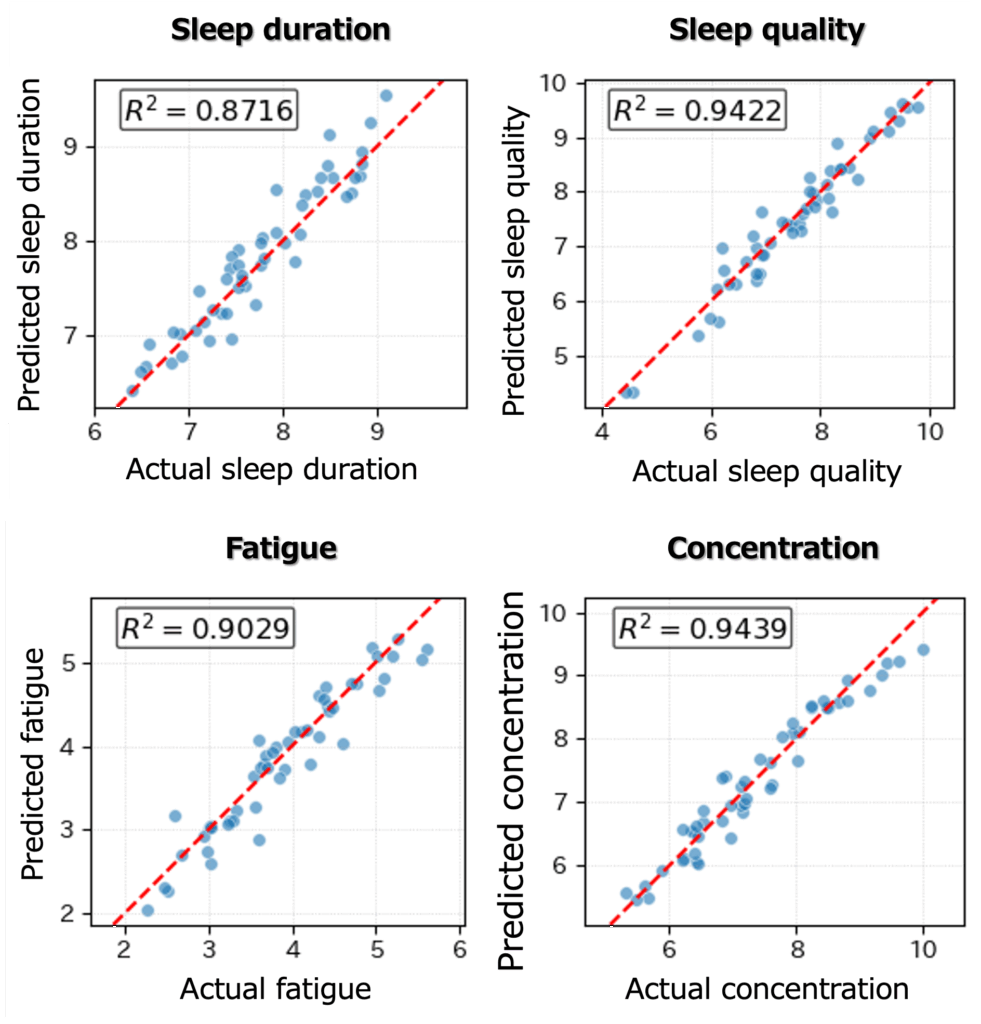Unlocking the Best Wake-Up with multiple AI: Optimizing Sleep Conditions through Multi-Sigma® AI Chain Analysis

“Despite sleeping well last night, I still feel unfocused today…”
“Could my difficulty concentrating be linked to the way I slept?”
Sleep plays a crucial role in determining the quality of our daily lives. It’s directly tied to mental and physical health, and ultimately to our daytime performance. Yet, discovering what makes for optimal sleep for oneself is far from simple. Factors like exercise duration, caffeine intake, and bedroom environment are deeply intertwined.
This complexity raises a compelling question:
“Can AI help unravel these complex relationships?”
To showcase the functionality of the predictive analytics software Multi-Sigma®, we conducted a mock analysis using synthetic sample data. The goal was:
To link multiple AI models in sequence to identify the optimal sleep conditions that minimize fatigue and maximize concentration the following day.
This exercise illustrates how even highly complex, multi-factor analyses can be executed efficiently and intuitively using Multi-Sigma®.
Why Multiple AI Models? — The Chain of Sleep Mechanisms
It’s believed that various lifestyle factors influence sleep quality:
- Daytime behaviors, including exercise duration, caffeine intake, and average sleep duration, influence that night’s sleep duration.
- Sleep duration, along with environmental factors such as bedroom temperature and light intensity, plays a critical role in determining sleep quality.
- In turn, sleep quality, together with exercise duration, affects next-day outcomes such as fatigue and concentration.
These relationships form a causal chain where each factor influences the next.
Attempting to model this entire process using a single large AI model often results in reduced interpretability and suboptimal learning performance. However, with Multi-Sigma®, the entire process can be decomposed into steps, each modeled by an independent AI and then connected to form a cohesive analytical pipeline.

Three AI Models Built with Multi-Sigma®
For this demonstration, we trained the following three models using Multi-Sigma®:
AI Model 1: Predicting Sleep duration
- Input: Past average sleep duration, Caffeine intake, Exercise duration
- Output: Sleep duration on the same day
- Purpose: This model learns how daytime activities influence sleep duration
AI Model 2: Predicting “Sleep Quality”
- Input: Bedroom temperature, Light intensity, Sleep duration (output from AI model 1)
- Output: Sleep quality for the same night
- Purpose: This model estimates how environmental conditions and actual sleep duration affect sleep quality.
AI Model 3: Predicting Fatigue & Concentration for the following day
- Input: Exercise duration during the previous day, Sleep quality from the previous night (output from Model 2)
- Output: Fatigue level and concentration level on the following day
- Purpose: This model evaluates how prior-day activities and sleep quality contribute to next-day performance and cognitive condition.
Thanks to Multi-Sigma®’s built-in neural network hyperparameter optimization, each model achieved a high level of predictive accuracy, as indicated by the following R² scores (with 1.0 representing perfect prediction):
- Model 1 (Sleep duration): 0.87
- Model 2 (Sleep Quality): 0.94
- Model 3 (Fatigue): 0.90, Concentration: 0.94

AI Chain Analysis: Linking Models with Multi-Sigma®
Multi-Sigma®’s AI chain analysis system enables multiple AI models to be connected in sequence, forming a logical flow of data and prediction. This functionality represents the core strength of the Multi-Sigma platform®.
The sleep duration predicted by Model 1 is automatically passed into Model 2, which combines this with environmental conditions to estimate sleep quality. The output from Model 2 becomes input for Model 3, which predicts fatigue and concentration levels for the following day. All model connections and configurations can be established through an intuitive graphical interface, requiring no programming expertise.
This AI chain analysis system supports three highly valuable capabilities:
- End-to-End Simulation
You can simulate how changes in the initial input (e.g., caffeine intake or bedroom temperature) affect final outcomes: next-day fatigue and concentration. Intermediate values such as sleep duration and sleep quality are also exposed, allowing users to understand how each variable propagates through the chain of effects. - Direct Attribution Analysis
You can quantitatively assess how much each original input contributes to the final outcome. - Optimal Input Exploration
You can find the ideal combination of input values to minimize fatigue and maximize concentration the next day.
What makes this especially powerful is that all of these advanced analyses can be performed without writing code or having deep machine learning expertise.
What Factors Shape Tomorrow’s Performance? (Factor Analysis)
Using Multi-Sigma®’s AI chain analysis, we examined how each initial input factor contributes to the final outputs—fatigue and concentration on the following day.

Several key insights emerged from the analysis:
- Bedroom environment plays a critical role. Both temperature and light intensity significantly influence next-day performance. When the temperature deviates from a comfortable range or when lighting is too bright, people tend to experience higher fatigue and reduced concentration the next day.
- Exercise duration also showed a significant impact. The results supported the widely accepted view that moderate physical activity can help reduce fatigue and improve cognitive performance the following day.
- In contrast, the impact of average sleep duration and caffeine intake appeared relatively minor in this artificial sample data compared to environmental and activity factors.
Multi-Sigma® excels at visualizing such causal relationships. It enables users to capture both direct and indirect effects of multiple variables on outcome metrics, all within a single, streamlined analysis.
What Sleep Conditions Lead to the “Best Wake-Up”? (Optimization Results)
To conclude the analysis, we used Multi-Sigma®’s optimization function to identify the combination of input values that would minimize fatigue and maximize concentration on the following day, based on predictions across the full AI model chain.


One example of a high-performing input combination identified by the AI is as follows:
- Average sleep duration: approximately 7.7 hours
- Exercise duration: approximately 58 minutes
- Caffeine intake: approximately 3.6 cups
- Bedroom temperature: approximately 21.0°C
- Light intensity: approximately 1.5 (lower values indicate a darker environment)
Under this condition the model predicted:
- Fatigue: approximately 1.86 (indicating low fatigue)
- Concentration: approximately 9.55 (indicating high concentration)
This configuration represents an ideal sleep environment and behavioral pattern for enhancing next-day performance.
The caffeine result may appear counterintuitive, as consuming 3.6 cups of coffee is generally not recommended for quality sleep. However, this outcome likely reflects characteristics specific to the artificial dataset used in the demonstration. Analyses based on real-world data could produce different and more nuanced recommendations.
Conclusion: Discover Deeper Insights with Multi-Sigma® AI Chain Analysis
In this article, we explored how Multi-Sigma®’s AI chain analysis system enables the integration of multiple AI models into a practical, end-to-end workflow. By using sleep optimization as a relatable example, we demonstrated how complex, interconnected factors can be analyzed and understood through a structured modeling approach.
Several key benefits of this method stand out:
- Improved understanding of complex systems: Enables intuitive modeling of sequential cause-and-effect relationships.
- Clarity on root causes: Helps identify which input variables have the most significant influence on final outcomes.
- Targeted optimization: Supports the discovery of specific input conditions that satisfy multiple objectives simultaneously.
These capabilities can be accessed through a user-friendly interface that requires no programming. The same AI chain analysis methodology can be extended beyond sleep science to areas such as manufacturing optimization, marketing analytics, and healthcare management.
We hope this overview encourages you to explore new ways to extract actionable insights from your data with the support of Multi-Sigma®.
機械学習を使った分析や予測が日常的に行われる今、協調フレームとしてのMulti-Sigma®の役割は増すばかりです。
『どのような場面で活用できるのか』をもっと知りたい方や、実際の利用シーンを見てみたい方は、是非一度お気軽にご相談ください。
In a world where machine learning-based analysis and prediction are becoming everyday practices, the role of Multi-Sigma® as a collaborative framework is more crucial than ever.
If you're interested in learning more about how it can be applied or want to see real-world examples, feel free to contact us.







